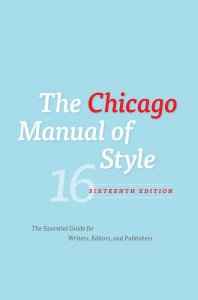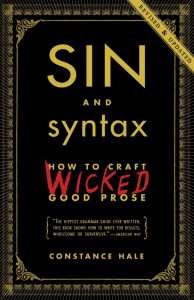by Angela Mergentime, Colorado Review editorial assistant
 Here at Colorado Review, we’re big fans of The Chicago Manual of Style. We rely on it for guidance on how and when to use em dashes, en dashes, and hyphens. We turn to it when we can’t remember whether to use a figure or spell out a number. And we depend on it when deciding whether to capitalize, italicize, or use quotation marks.
Here at Colorado Review, we’re big fans of The Chicago Manual of Style. We rely on it for guidance on how and when to use em dashes, en dashes, and hyphens. We turn to it when we can’t remember whether to use a figure or spell out a number. And we depend on it when deciding whether to capitalize, italicize, or use quotation marks.
Some writers, though, may be hesitant to turn to style manuals, daunted by their sheer size. Perhaps some are traumatized by haunting memories of Catholic school nuns enforcing the Rules of Grammar with those cutting red pen marks, rapping the knuckles of those who couldn’t remember whether the comma goes in or outside the quotation marks. But grammar and punctuation don’t need to be scary; in fact hair-raising style books can actually make it all so much less intimidating.
Style guides are not only for new writers either. Even experienced authors, already immune to the terrors of grammar, can find valuable techniques and forgotten methods or rules; they might even learn something new or sharpen their editorial skills. So this Halloween, with the spirit of the holiday lingering over my keyboard, I recommend that writers and editors alike turn to guides such as The Deluxe Transitive Vampire and Sin and Syntax.
Karen Elizabeth Gordon’s Deluxe Transitive Vampire: A Handbook of Grammar for the Innocent, the Eager, and the Doomed (1993) provides valuable explanations of grammar rules. The Deluxe Tra nsitive Vampire is a revision of the original 1984 Transitive Vampire, and it includes additional rules, fine points, examples, and illustrations. The book is divided into sections addressing sentences, words, verbs, adjectives, clauses, fragments, and so on. Gordon explains grammar and offers style advice through the use of creative sentences about vampires, bats, chimeras, gargoyles and the like, creating a spooky approach to style. She uses gothic art—wild spirits, dancing skeletons, winged frogs, and rats with guns—to illustrate grammar rules. Gordon credits eighteen sources for the illustrations, and their interaction with the text makes the study of grammar less staid, less menacing. In the book’s introduction, Gordon warns readers that she is “smuggling the injunctions of grammar into your cognizance through a ménage of revolving lunatics kidnapped into this book.”
nsitive Vampire is a revision of the original 1984 Transitive Vampire, and it includes additional rules, fine points, examples, and illustrations. The book is divided into sections addressing sentences, words, verbs, adjectives, clauses, fragments, and so on. Gordon explains grammar and offers style advice through the use of creative sentences about vampires, bats, chimeras, gargoyles and the like, creating a spooky approach to style. She uses gothic art—wild spirits, dancing skeletons, winged frogs, and rats with guns—to illustrate grammar rules. Gordon credits eighteen sources for the illustrations, and their interaction with the text makes the study of grammar less staid, less menacing. In the book’s introduction, Gordon warns readers that she is “smuggling the injunctions of grammar into your cognizance through a ménage of revolving lunatics kidnapped into this book.”
Gordon is also the author of The New Well-Tempered Sentence: A Punctuation Handbook for the Innocent, the Eager, and the Doomed, a convenient guide to punctuation with a similar gothic theme. Like The Transitive Vampire, The New-Well Tempered Sentence uses images from the dark side: bats, black cats, monsters, and the like. The first illustration in the book, included in the chapter on exclamation points, features a demon torturing souls in a fiery pit in hell with the caption “What a swell soirée this has turned out to be!” As in the Transitive Vampire, Gordon uses black humor to punch up her punctuation lessons. Her guides are particularly handy for writers and editors looking for a refresher in grammar and punctuation, something to augment The Chicago Manual of Style.
 Constance Hale’s Sin and Syntax: How to Craft Wicked Good Prose (2013) was likely influenced by Gordon’s guides and offers a creative approach to style with an entertaining narrative voice. The 2013 edition is a revised and updated version of the 2001 original Sin and Syntax: How to Craft Wickedly Effective Prose, and it includes new challenges and writing prompts in every chapter. Hale tells readers in her introduction that, unlike Gordon’s guides, Sin and Syntax is “really more about great writing than good grammar.” Sin and Syntax is divided into three main sections: “Words” (parts of speech), “Sentences” (parts of a sentence), and “Music” (melody, rhythm, lyricism, and voice). These sections are then divided into five subsections: “Bones” (grammatical background information), “Flesh” (lessons on writing), “Cardinal Sins” (examples of writing gone wrong), “Carnal Pleasures” (specimens of prose that transcend rigid adherence to rules), and “Catechism” (instructional exercises). This book may be especially useful for new writers looking to develop their own voice and flare. Although Sin and Syntax lacks images, it still positions style within a sinister theme by referring to style in terms of bones, flesh etc., making it a worthwhile and imaginative read for Halloween.
Constance Hale’s Sin and Syntax: How to Craft Wicked Good Prose (2013) was likely influenced by Gordon’s guides and offers a creative approach to style with an entertaining narrative voice. The 2013 edition is a revised and updated version of the 2001 original Sin and Syntax: How to Craft Wickedly Effective Prose, and it includes new challenges and writing prompts in every chapter. Hale tells readers in her introduction that, unlike Gordon’s guides, Sin and Syntax is “really more about great writing than good grammar.” Sin and Syntax is divided into three main sections: “Words” (parts of speech), “Sentences” (parts of a sentence), and “Music” (melody, rhythm, lyricism, and voice). These sections are then divided into five subsections: “Bones” (grammatical background information), “Flesh” (lessons on writing), “Cardinal Sins” (examples of writing gone wrong), “Carnal Pleasures” (specimens of prose that transcend rigid adherence to rules), and “Catechism” (instructional exercises). This book may be especially useful for new writers looking to develop their own voice and flare. Although Sin and Syntax lacks images, it still positions style within a sinister theme by referring to style in terms of bones, flesh etc., making it a worthwhile and imaginative read for Halloween.
Hale also wrote Hex, Vex, Smash and Smooch: Let Verbs Power Your Writing (2012), a helpful guide to verbs. This title explains verb moods, tenses, voices, classes, histories, gerunds, auxiliaries, and more. It also explores how to use established rules in new media to elevate writing for blogs and Twitter feeds, making it a great resource for online writers. On her website Hale describes it as “a book for every writer trying to figure out how to rise above the digital din by crafting prose that is lean, powerful, and punchy.”
Happy Halloween!